While the student executive of the early 1980s championed the activism of the era, successive leadership over the decade reflected changes in the broader political landscape. Women’s lib was giving way to neo-lib, and the voices troubled by Radio Active’s presence on VUWSA spreadsheets grew louder.
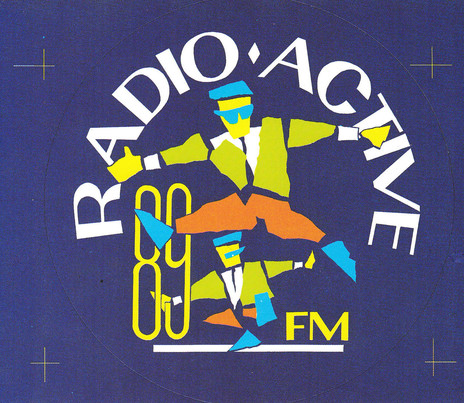
Radio Active 89 FM sticker. - Midge Murray collection
In 1987, VUWSA president (and future parliamentarian) Andrew Little campaigned for the association to stop funding Active. “While Radio Active is a high quality product and an important part of the association’s public profile,” he said, “it does not assist in achieving any of the association’s objectives. It does not assist in maintaining or improving the education or welfare of Victoria students, nor does it assist disadvantaged groups on campus. It does not help lobby government. It provides a limited service to a limited number of association members.”
The station waged a campaign rallying for student support at the next VUWSA meeting, and it was voted unanimously that funding should continue. Station stalwart Jim Scott would later recall, “The executive was always oblivious to the communication possibilities the station had for them. They never took advantage of the potential of Active as a tool for reaching the wider community. Instead, they tended to attack it rather than nurture it.”
Also in 1987, Wellington identity Gerald Dwyer founded and hosted The Wild Wild Rock Show. Ever the doer, Dwyer was simultaneously running his bill-posting company Sticky Fingers and performing in Flesh D-Vice (the band was a fixture of Wellington music for most of the decade). Dwyer moved on from hosting the show the following year, becoming manager for new bands Shihad and Head Like A Hole. Active would play a key role in the formative years of both bands, being the first radio station to play their music as well as supporting and promoting the live shows. This relationship was emblematic of the station’s role as a community hub for what would soon be a burgeoning Wellington music scene.

Gerald Dwyer, host of The Wild Wild Rock Show. - Void Ossuary collection
Around this time John Campbell (“Sparky Plug”) and co-host Jim Scott (“Friendly Brains”) were hosting The Alternative Rugby Commentary on the station. Though these sports broadcasts are most revered for constantly referring to penises (or “stiffies”), the ARC also led to Campbell being offered a cadetship at Radio New Zealand, nurturing the singular journalist and presenter he is today. Station technician Mark Roxburgh recalls, “The only reason they didn't get Active into trouble was anyone who would have actually taken offense was listening to the actual commentary.”
The year 1989 was especially significant for New Zealand broadcasting. In line with the broader neoliberal agenda of the era, broadcasting was deregulated. The government sold its commercial stations and began leasing the remaining frequencies to private entities. Thankfully, the Broadcasting Act (1989) exempted iwi and campus stations from the open market, and Active has operated with this safeguard since. However, with the privatisation of broadcasting on a national level and a broader mantra of embracing the free market, the future of Active as a funded arm of the VUWSA was questionable. A year later Metro magazine – unsettlingly confident in the long-term viability of the print format – published an article headlined “Is Student Radio Dying?”
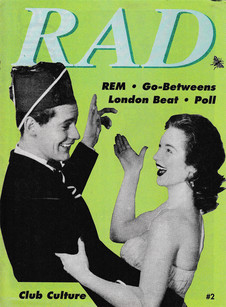
RAD, February 1989: a magazine launched by Mark Cubey, Michael Lockhart and station manager Mal McDonald. Recalls Cubey: “We wanted to help promote Active, so the station sold the ads and paid for the printing, and we did the content/design/production. Not a money maker.”
By 1992 there was severe tension between the station and the students’ association, and Active was evicted from the Student Union building. Keeping the station on air was a liability on the association’s books, and the introduction of student loans, increased student fees, and a push towards voluntary student association membership did not help matters. Station manager Michael Walls submitted a proposal to the executive, offering to take on the station and its $30k debt in exchange for the physical assets. Unfortunately, the proposal wasn’t clearly worded. VUWSA representatives were led to believe they were to both take on the debt and give away the station. They declined this offer, ordering station staff to vacate immediately. Given just minutes to leave, ‘Fight the Power’ was set to broadcast on repeat before staff exited the station and a security guard was stationed at the front door.
The eviction period was not long. Somebody had tipped TV3 off to the drama unfolding, with a news crew arriving as further negotiations ensued. This softened VUWSA president Cushla Aston’s approach to the situation, giving Walls the opportunity to convey that there had been a misinterpretation of his proposal. Staff were soon allowed back in, and the station resumed broadcasting, though with a stipulation there be no voice breaks. By 3pm the gag order was lifted and announcing resumed.
The events of that day in August 1992 led to the formation of Radio Active Ltd, a private radio station operating on a semi-commercial education licence. The station was now owned by a collective of 19 shareholders, each of whom invested $2000 to both settle the debt with the VUWSA and provide a modest budget for the station to find its feet. Though, for now, the station would remain in the Union Building and on campus, it was otherwise separate from the university and now able to freely cultivate an independent identity.
The 1990s would later prove to be a fruitful decade for student radio, but the station’s bottom line at this point was survival. With no more VUWSA funding and only modest seed money from investors, the station was running on an oily rag dipped in teen spirit. There was a series of clever station branding campaigns, spearheaded by Joanna Livingston, then in turn Megan Buchanan. The parental advisory stickers of the era were reappropriated as “Fuck Parental Advice” on a run of station-branded T-shirts. Other station T-shirts proclaimed, ‘The Devil Made Me Do It’ and ‘666 Active’. These campaigns served to position Active as a counterculture station rather than a student station (though this was a point sadly lost on the student union building caretaker at the time who – as programme director Paddy Moran found out when he locked himself out of the building – was genuinely scared of the devil worshippers on the second floor).
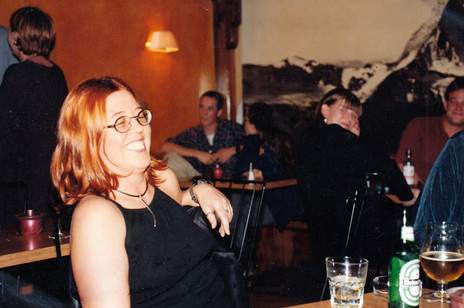
Megan Buchanan, Radio Active promotions, early 1990s. - Photo by Sarah Hunter
Buchanan instigated and promoted a series of significant station-branded events during this era, culminating in the remarkable yet ill-fated Private Function. As people had been turned away from her sold-out Bass Ball and Dance with Satan station events at the university hall, Active’s Private Function was scheduled to take place in a much larger disused waterfront shed. Modelled on 95bFM’s already established event of the same name, the large-scale night of entertainment was headlined by Shihad, Hallelujah Picassos, Headless Chickens, Emma Paki, and Steak. Though successful from the point of view of the artists and audience in attendance (and still cited as a testament to Buchanan’s tenacity and vision for Active) the event lost money, putting further strain on station finances.

Radio Active bumper sticker, c.1990. - Midge Murray collection
A year later, Active was struck a much deeper blow when it was revealed a staff member embezzled nearly $40,000 from the station. Press coverage of the subsequent court case reported that the Radio Active office manager stole $39,000 from the station between October 1993 and October 1994. The presiding judge stated that the loss of money had a serious effect on the activities of the station, noting that redundancies had to be made after the thieving was discovered. Those close to the station at the time recall the damage caused being far greater than financial.
Despite the precarity of the finances, the station remained creatively fertile. Production manager at the time, Miles Buckingham, would become one of the station’s most well-known and long-term identities. He reflects, “I began producing ads and promos during the dying days of analogue 8-track recording, having been taught how to operate the equipment by Mu [Chris Faiumu]. This was a mind-blowing wormhole into audio creativity where I could channel any manner of weird shizz from my brain into on-air advertising. When the station began selling 10-packs of generic blank cassette tapes I created entomologist Dr Ivan Linscott to sell them. To this day this is one of the most beautiful, tranquil pieces of advertising ever… ‘for the bug lover in you’. A listener actually yelled that at me from a passing car at the time… ‘for the bug lover in you.’” Station manager Peter Dickens once referred to Buckingham’s advertisements as “cannabis-induced visions”, ostensibly acknowledging the canonical weight of his output.
The Devil’s Lettuce also featured in a now-infamous 1993 broadcast of The Late Late Breakfast Show. Host Jak Pepsi recalls, “I was making a whole lot of mistakes, there had been some dead air and playing of records on the wrong speed, and I’d even taken the needle off a record that was playing on-air. I needed to relax so I hatched a plan. I had a giveaway on my show so I offered it to whoever could set me up with a 50 bag. To listeners this would’ve seemed like cheeky on-air banter. But I made the mistake of leaving the mic and phone channel on-air when I took the caller’s details, also broadcasting where and when I would later meet my new friend. As soon as the call ended the phone lit up again. It was Michael [Walls, station manager] telling me how many advertisers I had just alienated, followed by a call from Pete [Harrison, programme director]. He’d run three blocks to a phone booth after hearing the broadcast play through the speakers at Espressoholic.”
Pepsi’s hot-mic incident demonstrated an ongoing station dilemma, reconciling being a countercultural institution mainly staffed by volunteers with being a viable and professional radio station. Newly independent, the culture at the station was still in transition. Significant reforms at the station were not far off, but for now the newly independent organisation was still finding its footing. The station was also now officially part of the city rather than part of the university. Somewhere along the way there had also been a name change: Radio Active was now Active 89FM.
The timing of Active’s split from the VUWSA was quite good. Broader social and cultural stars were aligning for the station, both in Wellington and further afield. First, a significant shift was taking place in popular music. Seemingly overnight, music and culture that had long been considered underground, alternative, specialist, or just plain weird was finding much broader appeal. Grunge had replaced hair metal. Hip hop was on the ascent. Shoegaze had finally put British indie guitar on the map, forging the way for the Britpop to come. UK rave culture was taking hold elsewhere, in turn popularising electronic music. In a “pre-Internet world” Radio Active was a vital source for these emerging scenes and sounds in Wellington, particularly as commercial radio in New Zealand was not yet broadcasting any of it.

Radio Active sponsors the Wellington Fringe Festival, 1990s. - Midge Murray collection
Second, Wellington’s cultural infrastructure was developing and growing, with many new businesses, projects, and initiatives forming in and around the music, fashion, film, theatre, hospitality, events, and nightlife in the city. Active nurtured, supported, and promoted many of these new ventures, who in turn nurtured, supported, and promoted the newly independent station. Enduring relationships were formed with Bar Bodega, Starfish, Rex Royale, Little Gringo’s, Fidel’s, and Havana Coffee Works, among others. Later friends of the station included Southern Cross Garden Bar, ESC, Marmalade Audio, The Package, Kiwi Music Co, The Matterhorn, Sandwiches, Studio 9, Indigo, Iko Iko, Mandatory, Cosmic Corner, The Embassy, Paramount, and Penthouse Cinemas, Mighty Mighty, People’s Coffee, Supreme Coffee, Cuba Dupa, Bats Theatre, The Wellington Fringe Festival, San Fran, Good as Gold, Workingmen’s Bowling Club, Scopa, Floridita’s, Flipside, Loop Recordings, Cool Moves, NZ On Air, and numerous music and event promoters.
Third, many of Active’s show hosts were figureheads and organisers in this burgeoning cultural community. For example, Headstrong host Leon Baldock was attracting thousands of people to his Eden raves in the disused sheds of the waterfront, while Roots & Culture show hosts John Pell, Danny Lemon, and Chris Faiumu debuted their Roots Foundation Sound System nights at Taki Rua Theatre. Hosts of The Wild Wild Rock Show were embedded in the Carpark / Naked Angel / Outer Limits rock clubs, while a few years later Friday Night Flava’s “Sista Mary” O’Leary’s “Lush” fashion show-club nights featured local designers, choreographers, dancers, and VFX artists. By now Jason Harding’s alter ego Clinton Smiley was a bona fide Wellington identity, and his Thursday night show At Home With … was appointment listening.
Finally, New Zealand music was about to surge in popularity, which would significantly benefit the station in years to come. By now Active was a long-time supporter and promoter of New Zealand music, and an important hub for Wellington’s music community.
Conversely, commercial radio stations had long been averse to playing local music. In 1995 commercial radio playlists in New Zealand contained just one- to three-percent local music, most of which was Crowded House, Finn-adjacent, or ‘Poi E’. This meant the audience for New Zealand music at the time was limited. “There were three commercial radio stations in Wellington,” says Roxburgh, “and none of them were interested in local original music. Active was the only station that would play local bands’ demo tapes and recordings and promote their shows on air. It’s actually why I got involved and was willing to provide technical expertise at minimal cost.”

Jason Harding aka Clinton Smiley, late 1990s. - Photo by Sarah Hunter
By 1996 Active had been independent of the VUWSA for nearly four years. But like a lot of 19-year-olds, it was still living at home. That is, for all the initiatives to reposition Active from being Wellington’s student station to Wellington’s countercultural station, the studio and office was still based in the Student Union building of Victoria University’s Kelburn campus. By now this arrangement had created further tensions with the VUWSA, who were presumably tired of the teenager barricaded in its room all the time, the constant loud music, the strangers coming and going all hours of the day and night, and the general treating of the place like a hotel.

Mark Cubey models a Radio Active t-shirt he designed in the 1990s. - Photos by Lawrence Muir, 2022
It was in this climate that long-term station affiliate Mark Cubey took on the role of station manager, motivated by what he viewed as an organisation at a crossroads. Michael Walls had coordinated the VUWSA exit (1990-1992) before managing the newly independent company (1992-1993). He was followed by Jen Nolan in 1994, before Peter Dickens managed the station until midway through 1996. While each had played an important role in ushering a fledgling and modestly resourced organisation through its first few years, Cubey’s plan was significant reform. In a letter penned to the station’s board of directors he stated, “Active stands at a historic point, and needs to make a serious jump to a more professional level on all fronts if it is to survive in the face of increased competition in a growing media environment.”
Key to this plan was shaking off the less-desirable remnants of “student radio”, in turn better equipping and positioning the station for its future.
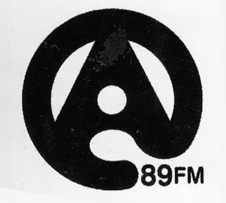
Radio Active @ sticker, 1990s.
Then-programme director Caron Copek (1996) recalls, “We were excited. He brought a sharp editorial ear to the station, and we’d often talk about the station’s sound. The timing was good too … the youth market was now a thing, and we were ready to ride a wave of advertising dollars without having to sell out or compromise.”
Andy Mitchell: “The station’s sound was all over the place when I started listening, but Mark picked up from where Peter Dickens had left off, further nurturing a new era of consistency and professionalism.”
On staff at the time was Lily Chalmers: “Mark’s focus was on making both the on-air and the day-to-day operation of the station more professional, and a lot of our initiatives from that era are still in place to this day.”
Some of the more visible adjustments of this era were the creation of the “@” station logo that endures to this day, the creation of the station’s first-ever paid DJ role, and – arguably most significantly – the move from Victoria University’s Kelburn Campus to Victoria Street in Wellington central. Though now ubiquitous, in 1996 the @ symbol had even less significance than the hash sign, which at least was a button on newer telephones. Chalmers recalls, “Mark drove that with a futurism we didn’t yet understand.” The logo design was a collaboration between Cubey and aptly named station DJ Jimmy Future.
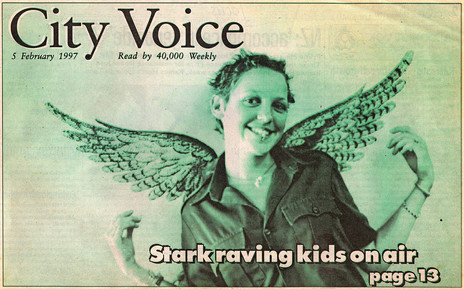
Rachel Sumner, a high-school student hosting her own show in 1997.
In May the following year Active announced the appointment of its first-ever first paid breakfast show host. Previously, each day had been hosted by a different volunteer DJ. The new host was a 20-year-old me, and the role was formative. Miles Buckingham remembers, “that Lewis fella with the ‘Lewis Lewis Lewis’ song forged himself as a genuine star within the parameters of what Active was, and advanced a level of pure anarchic entertainment into brekky.”
In January 1998 Radio Active moved from the university and into the World Trade Centre building in Wellington Central, later affectionately referred to as “Active Towers”. The move was a milestone for the station, both symbolically and practically. Active was now wholly separate from the university. It was also based in the centre of the city, rather than up a steep hill to the side of it. The building also housed Marmalade Audio, a highly regarded music and postproduction house. Marmalade was supportive of Active, providing discounted use of its studios and technical staff. As the station’s production studio was not yet fully digital, use of Marmalade’s facilities was a boon for recording advertisements and station imaging. Marmalade’s studios also hosted high quality live-to-air performances from local artists. Active Towers would later attract more kindred tenants, including Loop Recordings, Starfish, and printed gig guide The Package.
That year – 1998 – was a significant year for station-run events. Radio Active was turning 21, and the Wellington Town Hall was booked for a birthday party. The multi-room, multi-genre event was held on 21 December. The station released a compilation CD to celebrate, collated by Andy Mitchell.
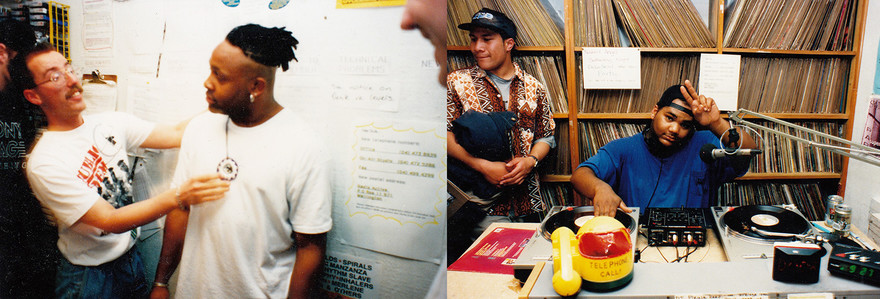
De La Soul at Radio Active, 1991. Left: Mike Lee aka Vicious gives style tips to Dave aka Trugoy the Dove from De La Soul. Right: a visitor with Vincent "Maseo" Mason of De La Soul at the wheels of steel.
“That was a privilege, and it was a perfect moment to cross over audiences from indie rock, noise, hip-hop and electronica,” says Mitchell. “And it included Fat Freddy’s first ever recording [‘Hope’].” Earlier in the year Active had presented its first ‘One Love’ event, devised by Chalmers to celebrate both Waitangi Day and Bob Marley’s birthday on February 6. Though this was a modest affair consisting of a van and some speakers, by 2006 the event was drawing 15,000 people. The station also held the first of its annual ‘Stars in Their Ears’ nights, a New Zealand Music Month event where contemporary Wellington bands covered New Zealand music classics. The year following Active held its first annual “Handle the Jandal” New Zealand music video competition and awards night, spearheaded by Robyn Walker.
Halfway through 1998 Cubey suddenly resigned. In a letter to the station’s shareholders dated September 1997, he outlined recent financial and operational improvements at the station, gains he suggested were made despite staff being under-resourced and him being under-supported. Still convinced of Active’s untapped potential, he presented an ultimatum. “Unless there are significant changes to staff structure and payment, and a commitment by the board to invest in the company’s future, there is no place for me here.”
Specific requests included moving downtown, creating a part-time promotions role, increasing the number of paid staff (while in turn significantly reducing the number of volunteer DJs), and appointing a full-time PA to the station manager role. It is not clear how the board responded, but over the following months Cubey became increasingly disillusioned, as well as increasingly volatile. In June 1998 he quit after 22 months in the role.

Dave Gibbons, long-serving station manager, late 1990s. - Photo by Sarah Hunter
His successor would run the station for two decades. Dave Gibbons’ appointment as station manager was unconventional. As Cubey had left suddenly, there was nobody managing the station in the months that followed. The board then called a staff meeting and announced that Gibbons – then Active’s sales manager – had expressed interest in the role. His appointment was to be determined by staff vote at the meeting, rather than the board considering him as part of a wider recruitment drive. Two staff members were overseas at the time so could not vote, though all but one person present supported the motion. The years that followed were fruitful for the station.
As the millenniums shifted, arts and culture in New Zealand was experiencing a boon. In turn, creative endeavours were becoming more visible and viable. In 1999, newly elected prime minister Helen Clark took on the Arts and Culture portfolio, rolling out a Cultural Recovery Package the following year. This included an initial $80 million investment in the arts sector, and $20 million a year over the three years following. The package focused specifically on the music and film industries, effectively doubling both NZOA’s music funding budget and the New Zealand Film Commission’s funding budget.
By this time New Zealand music was already on the ascent thanks to the Kiwi Music Action Group. Formed in 1997, the group launched New Zealand Music Week the same year, as well as other initiatives designed to raise awareness of local music (particularly within the commercial radio industry). By 2000, local music made up around 10% of commercial radio playlists, with 12 New Zealand artists entering the Top 40 that year. These figures would continue to increase in the years following. In 2001, Peter Jackson’s The Fellowship of the Ring was released, entrenching Wellington as a successful and prosperous centre for film production.
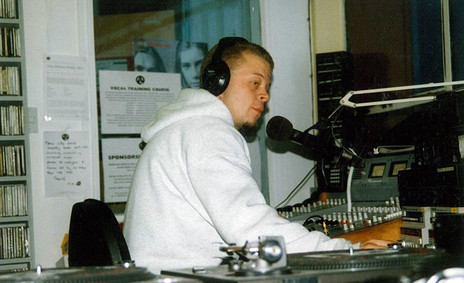
Lewis Tennant, Breakfast host in the Radio Active studio, 1997. - Lewis Tennant Collection
In the lead up to this cultural boom, Active – alongside the other now bNet stations – continued to nurture New Zealand music. Following Shihad and Head Like A Hole, Radio Active was first to play and support Wellington bands like Fur Patrol, Weta, Letterbox Lambs, and Hell is Other People. Though local hip hop was relatively scarce at the time, it was heavily played on the station. This included multiple tracks from Dam Native’s Kaupapa Driven Rhymes Uplifted, the Proud compilation, as well as King Kapisi and Che Fu.
More nascent was locally produced electronic music, inspiring Active staffer Lily Chalmers to release a compilation of Wellington producers in conjunction with Simon Swain from Obscure. Skankatronics was released in 1997. Radio Active was also vital for the promotion of likeminded gigs and events. In a 2017 Stuff article, publicist Sarah Hunter reflected on this era: “To make a gig happen you had to have Radio Active support it.”
Then there was Active’s role in what would become known as the “Wellington Sound”. In the years after the “play more reggae” sign appeared in the on-air studio, many Active DJs had championed a wide range of Jamaican-derived music. This included the reggae, dub, and dancehall produced on the island, as well as a broad spectrum of music coming out of the UK in the 1990s, including jungle, trip hop, house, rave, and UK garage. Roots & Culture (the station’s reggae show) was by now prominent on the station’s schedule. Then in the late 1990s Homebass was created, specialising in what would later be known as bass music. Meanwhile, members of TrinityRoots, Fat Freddy’s Drop, 50Hz, Bongmaster, and Ebb were in the station’s orbit, and Active supported the first recordings and gigs of many artists of this ilk.
One of the most well-known groups associated with the Wellington Sound started out as Radio Active’s in-house band. The band formed so the station would meet the requirements of Marmalade Audio’s Christmas party, the suitably titled “Marmalade Jam”. All entertainment on the night was to be provided by Marmalade clients, so Active staffers Rich Christie and Shannon Williams assembled The Active Assassins. Other band members included future Flight of the Conchords songwriter/performer Bret McKenzie, and Barnaby Weir (later to be Active production manager). The night went well and not long after, The Active Assassins changed their name to The Black Seeds.
By now the station’s presence in the central city was entrenched. Colyn Oliver-Clyne (business development manager 1999-2004) recalls, “The aim was for Active to be a social base. Somewhere all sorts of artists and creative people could come together and throw ideas around, as well as potentially collaborate. Friday nights were a noteworthy event, with beer and pizza donated from Little Gringo’s.”
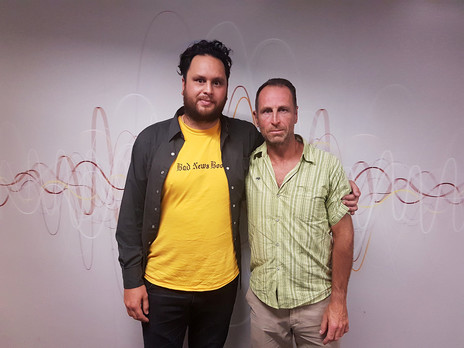
Max Scott-Murray (left) and his father Jim Scott share a long involvement with Radio Active. - Yadana Saw/RNZ, 2018
Phil Reed – variously Breakfast producer and host, Caffeine & Aspirin producer, and station publicist from 2004 to 2011 – adds, “Ladyhawke’s ‘Back of the Van’ was the signal. I’d be up at the station bathed in Friday afternoon sunlight (yes that does happen in Wellington), and that song meant the last working hours would morph into a party. We’d drink until sunset then adjourn to Matterhorn. Before long, half of Wellington’s entertainment sector would be hanging about … much to the chagrin of Rex Royale’s bar tab.”
The soundtrack to Friday Drive was provided by Jim Scott, who later co-hosted the show with his son Max Scott-Murray. Max’s mother Midge was also close to Active, having been programme director in 1989, station manager the following year, as well as a station DJ from 1987 to 2010. Jim also had a long history with the station, having filled various on- and off-air roles since the 1980s, including being the aforementioned “Friendly Brains” to John Campbell’s “Sparky Plug”. Consequently, Max grew up in and around Radio Active, and the childhood voice of his sister Wai featured on station IDs that played for many years. Speaking about the co-hosting role to RNZ in 2018, Murray-Scott offered, “I don’t know how I got roped into it. I guess it’s a natural progression … growing up around the Active whānau as long as I can remember … it’s always just kind of been there in our lives.” Sadly, Scott-Murray and Radio Active family member Wai passed away in 2007.
--